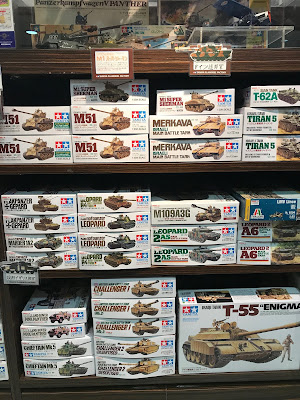Recently, the missus had to go on week-long work trip to Japan. And because of her hectic schedule, she didn't have much free time to roam the streets of Tokyo for some shopping. But as luck would have it, she did manage to make an unexpected trip to the
Tamiya Plamodel Factory in Tokyo. While there are probably better deals to be had in hobby shops in Akihabara, the Tamiya flagship store presumably has a wider range of its own products. Regardless, it's an awesome shop in its own right.
 |
| Tamiya Plamodel Factory in Tokyo, Japan |
Being a spur of the moment decision, the missus only reached Tamiya's store rather late in the evening. So with closing time not too far off and a need to make the last train out of Shimbasi District where the store is located, she began sending me quickfire photos of Armored Fighting Vehicle (AFV) model kits. Her question ...
was there anything I wanted? For a moment, I just froze. My mind blank, unable to really process the multitude of Tamiya model kits on display.
 |
| Behind the main display window of the Tamiya Plamodel Factory in Tokyo |
 |
| Standing out among the German and Finnish WW2 kits is the 50th Anniversary Panther Ausf.D |
 |
| Tamiya 1/35 scale model kits mostly from the modern era |
 |
| Russia and Italian armor as well as military figure kits |
 |
| Some 1/35 scale accessory parts, British armor, French armor and soldiers |
Well, it was a moot question and the missus knew it. What there anything I wanted? Well, a better question would've been was there anything that I
didn't want? Anyway, I recovered my senses soon enough and my initial exhilaration wore off quickly as I grappled with the realities of
want versus
budget. While the former is insatiable, there is never enough of the latter. So after a fair bit of dilly-dallying with choices made, unmade and remade, I eventually settled on a selection of AFVs entirely from the World War II era. Most were Wehrmacht armor with an iconic Russian tank thrown in.
 |
American armor and artillery including the more well known
M4A3E8 Sherman Easy
Eight
|
 |
| Scale model equivalents of vehicles in the Wehrmacht Panzer and Panzergrenadier Divisions |
 |
| Yet more 1/35 scale German armor including the infamous ... |
 |
| 1/35 scale Japan Ground Self Defense Force model kits and 1/16 military figures |
 |
| On the lowest shelf are Tamiya's large 1/16 scale model kits |
Other than the wide selection of 1/35 scale model kits that were my main focus, there was also a good selection of 1/48 scale model kits in the Tokyo flagship store (
see below). But because kits at this slightly smaller scale are pretty rare in the local hobby shops that I frequent, I never really took to building them. I believe Tamiya is one of the (if not) main producers of 1/48 scale military vehicles.
 |
| Tamiya Plamodel Factory (Tokyo) has a huge collection of 1/48 scale AFVs |
 |
| More 1/48 kits and some rare 1/25 scale remote control tanks |
 |
| German and Russian 1/48 scale model kits |
 |
| British and American 1/48 scale model kits |
 |
| Ships aren't my thing but the Japanese Battleship Yamato was tempting |
In hindsight, I should've taken a more careful look at the various tools and accessories available in the shop. There were certainly a few stuff I could've used in some upcoming projects. That being said, I don't regret it too much as my priority then was getting my hands on a few hard-to-find kits.
 |
| Tamiya paint brushes, weathering master sets and miscellaneous tools |
 |
| Closeup of Tamiya's premium paint brushes |
 |
| A wide selection of Tamiya airbrushes |
 |
| More Tamiya airbrushes and air compressors |
 |
| Tamiya Electric Handy Drill, which actually needs to be assembled like a model kit |
 |
| Various types of Tamiya branded glues |
In the end, things ended up more expensive than anticipated. It turned out there was a 8% sales tax yet to be included into the final prices on display. Moreover the Tamiya Plamodel Factory in Tokyo was unfortunately a shop that didn't reimburse tourists for the tax. Prior to bringing the kits you see below to the cashier, the missus had actually upon my request returned a number of Russian tanks (i.e. the
KV-1B,
Su-85 and
Su-122) back to the display shelf in order to keep the bill low. And with the added tax I was prepared to return a further two kits to the shelf but she kindly suggested I keep them as it wasn't everyday that she got the chance to visit Tamiya's flagship store.
 |
| What my missus got for me from Tokyo's Tamiya Plamodel Factory |
Apart from the
Pz.Kpfw.IV Ausf.J 50th Anniversary Special Edition kit
, the others came packaged in smaller sizes than your average Tamiya box. Correspondingly, they were cheaper than what an average 1/35 scale Tamiya kit retails for. Now I'm not a Tamiya fanboy by any means but I do appreciate the quality of their kits. So I was extremely happy with her haul in Tokyo, especially the
Russian T34/85 Medium Tank. What's more, there was icing on the cake in that the missus bought
all of them for me. Talk about having your cake and eating it too, icing and all. Looks like Xmas came early for me. On that note, here's wishing you a Merry Christmas and a Happy New Year.
















.jpg)










